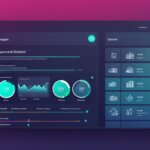Table of Contents
Software as a Service (SaaS) is a revolutionary approach to software distribution that has transformed the way businesses and individuals utilize technology. In this article, we will explore the ins and outs of SaaS, its benefits, and its impact on business operations.
SaaS, also known as software on-demand, is a cloud computing solution where applications are hosted and made available to users over the internet. It falls under the broader category of cloud computing solutions, alongside Infrastructure as a Service (IaaS) and Platform as a Service (PaaS).
SaaS is designed to meet the needs of both business users and personal users. It effectively eliminates the need for installing and maintaining software on individual computers or data centers, making it a cost-effective solution for businesses of all sizes.
One of the key advantages of SaaS is its accessibility. Users can access SaaS applications from any device with an internet connection, making it a flexible and convenient option for remote work or international offices. The ability to customize and integrate SaaS applications with other software allows businesses to tailor their solutions to their specific needs and streamline their operations.
As the SaaS market continues to grow rapidly, with predictions of reaching $200 billion by 2024, it is clear that businesses and individuals are recognizing the value and potential of this innovative software distribution model.
In the following sections of this article, we will delve deeper into how SaaS impacts business operations and the importance of ensuring security and privacy in SaaS applications.
How SaaS Impacts Business Operations
SaaS (Software as a Service) offers businesses cost-effective solutions by eliminating the need for hardware acquisition, infrastructure setup, and software installation and support. By subscribing to a SaaS application, businesses can exercise better budgeting and terminate the subscription at any time. This flexibility allows businesses to optimize their resources and scale their usage of services and features on demand, making SaaS an ideal choice for both small and large enterprises.
One of the key advantages of SaaS is its accessibility. With SaaS applications, businesses can access their software and data from anywhere with an internet connection. This allows for remote work and encourages collaboration among employees, even across different locations or international offices. The ability to work on the go greatly enhances productivity and efficiency.
SaaS applications also offer customization options that allow businesses to tailor the software to their specific needs. Whether it’s customizing workflows, branding, or user interfaces, SaaS solutions provide the flexibility to adapt and align with business processes. Furthermore, SaaS applications can be seamlessly integrated with other business applications, enabling a unified system that streamlines operations and eliminates data silos.
To illustrate the impact of SaaS on business operations, consider the following example:
Case Study: Streamlining Customer Relationship Management (CRM)
A company, XYZ Enterprises, relied on a traditional CRM system hosted on its own servers. The system required significant upfront investment in hardware, software licenses, and IT support. As the company expanded, maintaining and upgrading the CRM became increasingly complex and costly.
Seeking a more flexible and cost-effective solution, XYZ Enterprises migrated to a cloud-based SaaS CRM. The subscription-based model allowed them to allocate resources more efficiently and scale their usage as their business needs evolved. The SaaS CRM was accessible to all employees, regardless of their location, facilitating collaboration and improving response times to customer inquiries.
Additionally, the SaaS CRM offered customization options that aligned with XYZ Enterprises’ sales process. The company was able to create custom fields and workflows, tailored reporting, and integration with other tools such as email marketing software. This integration enabled a seamless flow of data and eliminated manual data entry, saving time and improving data accuracy.
Overall, the migration to a SaaS CRM not only reduced costs but also improved the efficiency and effectiveness of XYZ Enterprises’ sales and customer management processes.
In conclusion, SaaS has a transformative impact on business operations. Its cost-effective nature, flexibility, accessibility, customization options, and integration capabilities make it a compelling choice for businesses looking to optimize their operations and drive growth.
Ensuring Security and Privacy in SaaS
While Software as a Service (SaaS) offers numerous benefits, it is imperative to address the critical concerns surrounding cybersecurity risks, encryption, identity and access management (IAM), and data residency requirements. In the SaaS model, the responsibility for security lies with the software vendor and the cloud provider. Encryption and key management play a crucial role in securing sensitive data transmitted and stored within SaaS applications.
Furthermore, robust identity and access management systems must be in place to ensure authorized user access and prevent unauthorized breaches. Monitoring and responding to security incidents promptly enables proactive threat detection and mitigation.
Compliance with data residency requirements is essential for businesses operating in different jurisdictions. SaaS providers need to adhere to data protection regulations to safeguard user data and honor data privacy commitments. Alongside these considerations, businesses must evaluate the cost of investing in third-party tools to bolster security measures and mitigate risks.
To establish a secure SaaS environment, businesses should carefully evaluate their SaaS providers’ security measures, service level agreements (SLAs), and data protection policies. Open communication with technical and security experts during the evaluation and implementation phases is vital to prioritize cybersecurity measures and ensure a smooth transition to SaaS solutions.
FAQ
What is SaaS experience?
SaaS experience refers to the user experience of using software as a service. It involves accessing and using software applications hosted and maintained by a cloud provider over the internet, eliminating the need for users to install and maintain the software on their own devices or data centers.
What is software as a service?
Software as a Service (SaaS) is a software distribution model where applications are hosted and made accessible to end users over the internet by a cloud provider. It is a type of cloud computing solution that allows users to access software applications through subscription-based payment models.
Who uses SaaS?
SaaS applications are used by a range of users, including business professionals and personal users. They can be marketed to both B2B and B2C customers, offering solutions for various industries and individual needs.
How does SaaS impact business operations?
SaaS offers cost-effective solutions for businesses by eliminating the need for hardware acquisition, infrastructure setup, and software installation and support. It provides flexibility and scalability, allowing businesses to access and adjust their usage of services or features on demand. SaaS also enables remote work and international offices, as applications can be accessed from anywhere with an internet connection. Additionally, SaaS applications can be customized and integrated with other business applications, enhancing productivity and streamlining operations.
How can SaaS ensure security and privacy?
Security and privacy in SaaS are essential considerations. The responsibility for security lies with the software vendor and the cloud provider. Risks can arise from encryption and key management, identity and access management (IAM), security monitoring, incident response, integration into broader security environments, data residency requirements, data privacy, and the cost of investing in third-party tools to mitigate security risks. It is crucial for businesses to carefully evaluate their SaaS provider’s security measures, Service Level Agreements (SLAs), and data protection policies. Prioritizing cybersecurity measures and collaborating with technical and security experts during the evaluation and implementation of SaaS solutions is important to ensure security and privacy.







